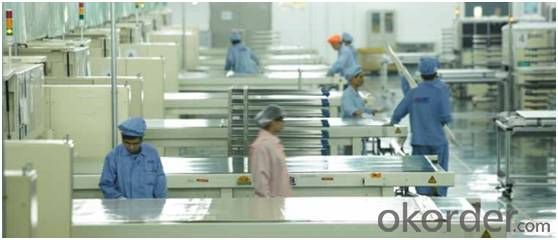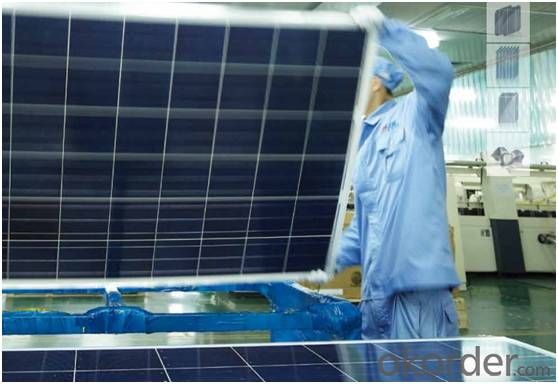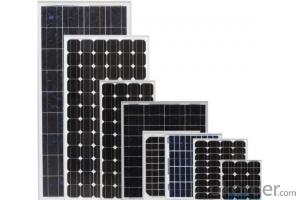Off-grid Solar Panel TDB125×125/4-36-P Lower Weight Design
- Loading Port:
- Ningbo
- Payment Terms:
- TT OR LC
- Min Order Qty:
- 100 carton
- Supply Capability:
- 10000 carton/month
OKorder Service Pledge
OKorder Financial Service
You Might Also Like

Specification:
· Highest performance enabled by higher efficiency monocrystal line cells and the latest Solar Wafer Technology for multicrystal line cells
· Lower weight design which reduces the total system load on a roof, making it ideal for residential customers. Its shape allows for better roof utilization
· Its low weight means easier handling for installers
· Modules are designed to withstand PID (Potential Induced Degradation)*
· High light transmission Anti-Reflective Glass with improved self-cleaning capability
· 0/+5 W Positive power tolerance for reliable power output
Warranty
CNBM Solar provides one of the most comprehensive module warranties in the industry:
· 10 years for product defects in materials and workmanship
· First 12 years for 90% of warranted minimum power
· Remaining 25 years for 80% of warranted minimum power
Certification
CNBM Solar strictly carries out the ISO 9001 quality control methodology and has implemented check points at every step of the production process to ensure our product performance durability and safety. The stringent quality control process has been confirmed by numerous independent agencies and LDK Solar modules earned IEC, TUV and UL certifications.
· IEC:IEC 61215, IEC 61730 (1&2), conformity to CE
· UL 1703 2002/03/15 Ed:3 Rev:2004/06/30
· ULC/ORD-C1703-01 Second Edition 2001/01/01
· UL and Canadian Standard for Safety Flat-Plate
· ISO 9001: 2008 Quality Management Systems
· CEC Listed: Modules are eligible for California Rebates
· PV Cycle: Voluntary module take back and recycling program
· MCS Certificate



FAQ
1. How do I decide which system is right for me ?
For protection from long outages, include a generator or solar panels in your Must solar system. Shorter outages can be handled by a battery-only system.
2. Where my system will be installed ?
Must solar systems are usually wall-mounted near a home's main electrical (circuit breaker) panel.
3. How do I install my system ?
A must solar backup inverter is connected to a home electric system , we will supply detailed installation manual and videos for our customers .
How fast will my system respond to a power outage ?
Must solar inverters typically transfer to battery power in less than 16 milliseconds (less than 1/50th of a second).
What kind of batteries do the systems include ?
Must solar backup electric systems use special high-quality electric storage batteries.
- Q:cheapest price for a 20 watt solar panel sold on line
- Solar panels installed are roughly $0/watt in commercial quantities. Bare panels? Do a google search and see what you can find. But for the record, there are panels and there are panels. Stuff from China put together in a shed somewhere will not perform in the same way as some of the new thin-film amorphous panels coming out of the US and Europe. So, in many ways you get exactly what you pay for.
- Q:I want to know how to hook up a Solartech SPM020P-R, 20W Solar Panel to a single outlet that you can but at a store.
- That solar panel puts out about amp (in round numbers). If you are talking about a 20vac outlet, you'll have to send the output of the solar panel through an inverter. That brings it up to 20vac. 20 watts at 20 volts means you'll only be able to draw 0.6667 amps. With an inverter at 85% efficiency, you'll only get about 0.4 amps. That would barely light a CFL. 20 watts of power at 7 volts = amp (in round numbers) 20 watts of power at 20vac = 0.6667 amp (in round numbers) Power (watts) = current x voltage. If you increase voltate, you must decrease current to get the same watts. Watts is the common denominator in power measurement.
- Q:How do solar panels affect the property's energy management system?
- Solar panels can have a significant impact on a property's energy management system. By converting sunlight into electricity, solar panels can provide a clean and renewable source of power, reducing the property's dependence on traditional energy sources. This can lead to significant cost savings on electricity bills and also help to reduce the property's carbon footprint. Additionally, solar panels can integrate with the property's energy management system, allowing for better monitoring and control of energy usage, optimizing the overall efficiency of the system.
- Q:I need to reduce the average monthly home electricity bill by powering some of the household appliances using solar panels. Can I use a 250 watt solar panel to power a medium sized upright fridge?
- Well you might reduce your bills, but you wont get your capital back for many years. Do you have LED lighting, I have, every-time one of my compact flourescent bulbs blew I would replace it with an LED, after two years most of my lighting is LED, a good investment I think. What devices do you have, heating and cooking is better with gas (much cheaper) Think about better insulation for wintertime.
- Q:I've run out of things to keep me entertained recently and as part of a larger project, I was curious if its possible to 'McGuyver' up a solar panel out of common materials?
- It okorder /
- Q:Can solar panels be used for powering a research facility or laboratory?
- Yes, solar panels can be used to power a research facility or laboratory. Solar energy is a renewable and sustainable source of power that can provide electricity to such facilities. By installing solar panels, the research facility can reduce its dependence on traditional energy sources, lower its carbon footprint, and potentially save on energy costs in the long run.
- Q:They absorb solar heat and transform it into electricity, so there should be less heat left to warm the planet. Shouldn't we at least plaster all the world's deserts with them?
- The opposite - they heat the Earth up. The ground underneath might be brown or green or sand. The solar panels are Black. They absorb more radiant energy. Solar electricity is energy and somewhere down the wire will produce heat. Solar's saving grace is that it has the same heating effect year after year. But greenhouse gasses have a cumulative effect. The excess gasses produced in year one are added to the gasses in year two, etc. For instance say the heating of soalr cells is 5 times (5s) that of greenhouse gasses (g). Year - Total Heating - 5s + g 2 - 5s + 2g 3 - 5s + 3g 4 - 5s + 4g 5 - 5s + 5g 6 - 5s + 6g 7 - 5s + 7g 8 - 5s + 8g 9 - 5s + 9g 0 - 5s + 0g etc... In 50 years you have 50 - 5s + 50g
- Q:how the energy of load connected to solar PV measure.?Want too the basic idea about it.The role of current flowing thrugh the load?Can u explain with example..can explain simply?Im not an electrical student so explain very basics
- A solar panel is made up of solar cells. Each cell produces about 0.5 to 0.6 volts. Cells are connected in series, like the batteries in a flashlight. Enough cells are placed in series to produce the desired voltage. Cells produce very little current, so many strings of cells are connected in parallel to produce sufficient current. The output is direct current (DC), like that from a battery. A home solar system needs alternating current (AC), so an inverter is used to change from DC to AC. Some systems have batteries for backup power. In these some of the DC output is used to keep the batteries charged. Systems are measured in kilowatts. System sizes are chosen to meet the demands for electricity. My system has a 6 kilowatt (kW) rating. The true output is more like 4. Now that you know this much you can Google SOLAR SYSTEMS to learn more.
- Q:how much power is generated with solar panels? also please give me links for that information.and how much would the costs be for this alternative energy source?
- KW solar panels generate 5kwh power each day or so.
- Q:What is the warranty on solar panels?
- The warranty on solar panels typically ranges from 10 to 25 years, depending on the manufacturer.
1. Manufacturer Overview |
|
|---|---|
| Location | |
| Year Established | |
| Annual Output Value | |
| Main Markets | |
| Company Certifications | |
2. Manufacturer Certificates |
|
|---|---|
| a) Certification Name | |
| Range | |
| Reference | |
| Validity Period | |
3. Manufacturer Capability |
|
|---|---|
| a)Trade Capacity | |
| Nearest Port | |
| Export Percentage | |
| No.of Employees in Trade Department | |
| Language Spoken: | |
| b)Factory Information | |
| Factory Size: | |
| No. of Production Lines | |
| Contract Manufacturing | |
| Product Price Range | |
Send your message to us
Off-grid Solar Panel TDB125×125/4-36-P Lower Weight Design
- Loading Port:
- Ningbo
- Payment Terms:
- TT OR LC
- Min Order Qty:
- 100 carton
- Supply Capability:
- 10000 carton/month
OKorder Service Pledge
OKorder Financial Service
Similar products
New products
Hot products
Related keywords





























